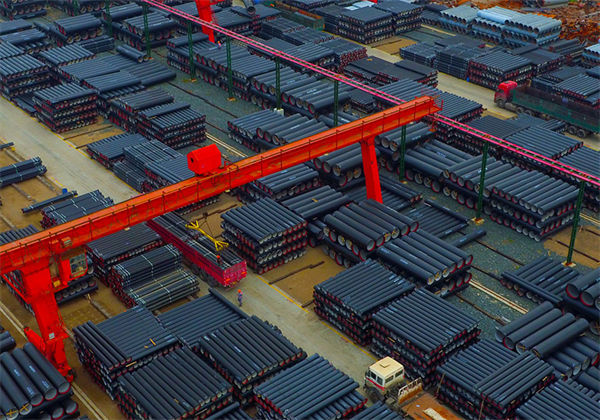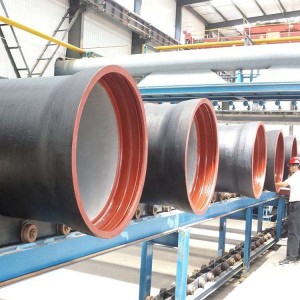Factory and Warehouse
Product Form
Ductile Iron Pipes All Types:
|
1 |
Material |
Ductile Cast Iron |
|
2 |
Joint Type |
T-Type(push-on joint) |
| K-Type(Mechanical Joint) | ||
| Self-Restrained | ||
| Flanged joint | ||
|
3 |
Standard |
ISO2531, EN545, EN598, etc |
|
4 |
Size |
DN80 - DN2600 (80mm - 2600mm) |
|
5 |
Classs |
K7, K8, K9, C40, C30, C25, etc |
|
6 |
Length |
6m, cut to 5.7m |
|
7 |
Internal lining
|
1. Portland cement mortar lining |
| 2. Sulphate Resistant cement mortar lining | ||
| 3. High-Aluminum cement mortar lining | ||
| 4. Epoxy Resin Lining | ||
| 5. Epoxy Ceramic Lining | ||
| 6. PU Lining | ||
|
8 |
External Coating |
Zinc+bitumen coating, |
| Customized coating such as Zinc-Epoxy, Alumina Powder, PU, FBE, Epoxy-Ceramic, etc. | ||
|
9 |
Rubber Gasket |
NBR rubber, SBR rubber or EPDM rubber ring as per ISO4633 |
|
10 |
Application |
Potable Water / Drinking Water/Sewage Water |
|
11 |
Packing |
DN100-DN300 in bundles; DN350-DN2600 in bulk ship |
Introduction

Our Ductile Iron Pipe ISO 2531 - the epitome of excellence in piping solutions. Crafted with precision using premium ductile iron material, our pipes are engineered to endure the most demanding water and wastewater applications. Complying with the stringent ISO 2531 standards, these pipes guarantee unrivaled quality and safety.
Built to last, our Ductile Iron Pipe boasts a robust construction that can withstand heavy loads, high pressures, and harsh environmental conditions. Its superior corrosion resistance ensures long-term durability, significantly reducing maintenance requirements and lifecycle costs.
Versatility is key - available in a wide range of sizes and pressure ratings, our Ductile Iron Pipe adapts seamlessly to diverse project specifications. From municipal water supply networks to industrial applications, these pipes deliver exceptional performance without compromise.
Easy installation is at your fingertips, thanks to the pipes' user-friendly design and lightweight properties. Enhance project efficiency while contributing to sustainable development, as our Ductile Iron Pipe is eco-friendly and recyclable.
Trust in the reliability, efficiency, and durability of our Ductile Iron Pipe ISO 2531. Join numerous satisfied customers who have experienced the benefits of our top-tier piping solution. Elevate your water transportation systems with our premium pipes, setting new standards of excellence in the industry.
Benefits of ductile iron pipe

Solid under loads
In underground conditions, the ductile cast iron pipe has a semi-rigid behaviour: it offers an excellent compromise between mechanical stress in the wall (small DN) and ovality (large DN). It can be laid in high and low height of cover, and easily in soil of low rigidity. The ”ground/semi-rigid pipe” system offers optimum mechanical stability over time, without risk of buckling in large DN.

Insensitive impacts
The ductile cast iron structure has a high elastic deformability and a high resistance to crack initiation: it results in excellent impact resistance. The cast iron pipes are perfectly suited to transport conditions over long distances (truck, train or ship), handling conditions on sites and to different types of backfilling. The ductile cast iron pipelines may be laid in very difficult areas: rocky mountain slopes for hydroelectric plants, crossings for cantilever bridges, rockfill for submarine outlets.

Push-in joint system

Excellent hydraulicity
The centrifugation process ensures a perfectly smooth and even cement surface. The Colebrook roughness coefficient of an isolated pipe is k = 0.03 mm. We recommend the use of an average value of k = 0.1 mm for sizing networks in order to take into account all the different load losses caused by singular points (tee fittings, elbows, valves, etc.)

Pressure resistance
The ductile cast iron pipe are designed to withstand pressures much greater than the values usually encountered on the networks. The wall thickness is calculated with a safety factor of 3 with respect to the maximum operating pressure. This additional safety margin is very useful to the impacts during installation, accidental overpressure and mechanical operating fatigue.











